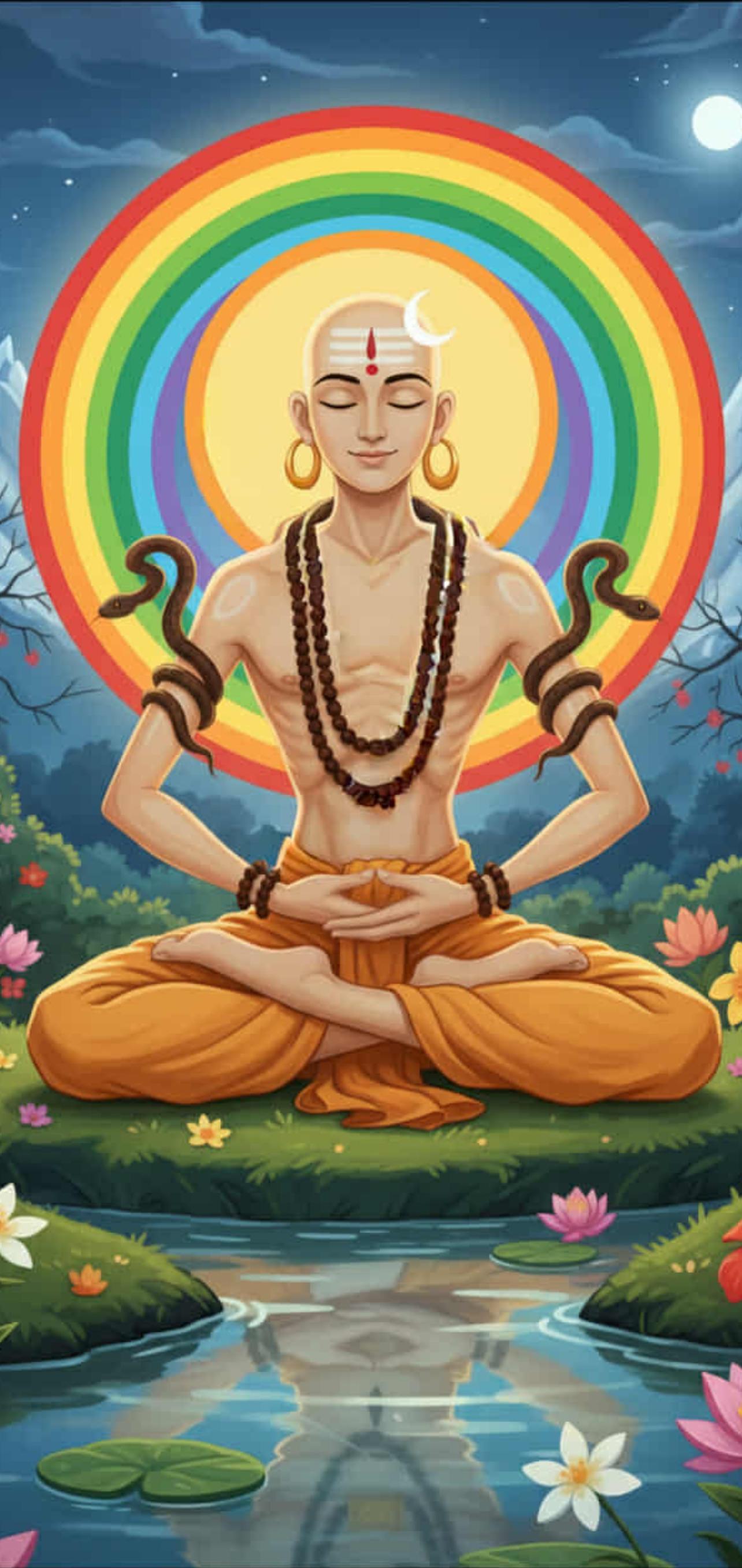Matrika Bhairava is regarded as one of the most elevated and secretive manifestations of Shiva within the Tantric tradition. What makes Matrika Bhairava extraordinary is that He contains the full force of every Matrika tradition: the Ashta Matrikas, the Shodasha Matrikas, and the Varna Matrikas. Instead of worshipping these goddesses separately, Tantric teachings reveal that all their energies converge and shine through this single, supreme deity. For that reason, Matrika Bhairava is celebrated as the ultimate source of mantra shakti, the primordial root from which all sacred sounds and mantras arise.
Within this majestic form reside three of the greatest Shaktis—Brahmi, Mahalakshmi, and Mahagauri. Practitioners pursuing mantra siddhi or wishing to intensify their spiritual evolution often choose Him as their Ishta Devata, because He governs the very vibration, potency, and life-force of all mantras. In Tantric understanding, every mantra’s root energy flows directly from the consciousness of Matrika Bhairava.
At a deeper and more esoteric level of Tantra, Matrika Bhairava is said to hold within Himself some secret Matrikas represent subtle dimensions of spiritual awakening: inner expansion, divine brilliance, and transformative silence. Only highly advanced practitioners are traditionally introduced to the mysteries of these Matrikas, and it is their presence that elevates Matrika Bhairava to a status higher than most forms of Bhairava. Because He embodies the totality of all Matrika powers, both revealed and hidden, He is considered capable of guiding a seeker toward the highest spiritual goals.
Tantric scriptures state that sincere worship of Matrika Bhairava has the potential to grant a practitioner liberation, complete mastery over spiritual energies, and ultimately the state of siddhatva—full spiritual accomplishment. His path is not like ordinary worship; it is deeply mystical, inner-oriented, and based on subtle mantra and energy practices. The methods associated with Matrika Bhairava require a level of discipline and dedication suited for those who are genuinely committed to transformative spiritual growth. To know more about the Matrika Bhairav and his sadhana system, here is an article about Matrika bhairava on siddhapedia containing in detail information.
https://siddhapedia.com/matrika-bhairava
#matrikabhairava #Matrika #ashtamatrika #bhairav #HimalayanDevaParamapara #SiddhaDharma #Siddhatradition #LordShiva #BhagwanShiv #Mahadev #SwachhandBhairav #kurukulla #Siddhapedia #kaulantakpeeth #kulantpeeth #Ishaputra #MahasiddhaIshaputra #MahayogiSatyendraNath #Meditation #sanatandharma #HimalayanSiddhas #Hindu #Adhyaatma #himalayangod #iksvp #scrolllink
Within this majestic form reside three of the greatest Shaktis—Brahmi, Mahalakshmi, and Mahagauri. Practitioners pursuing mantra siddhi or wishing to intensify their spiritual evolution often choose Him as their Ishta Devata, because He governs the very vibration, potency, and life-force of all mantras. In Tantric understanding, every mantra’s root energy flows directly from the consciousness of Matrika Bhairava.
At a deeper and more esoteric level of Tantra, Matrika Bhairava is said to hold within Himself some secret Matrikas represent subtle dimensions of spiritual awakening: inner expansion, divine brilliance, and transformative silence. Only highly advanced practitioners are traditionally introduced to the mysteries of these Matrikas, and it is their presence that elevates Matrika Bhairava to a status higher than most forms of Bhairava. Because He embodies the totality of all Matrika powers, both revealed and hidden, He is considered capable of guiding a seeker toward the highest spiritual goals.
Tantric scriptures state that sincere worship of Matrika Bhairava has the potential to grant a practitioner liberation, complete mastery over spiritual energies, and ultimately the state of siddhatva—full spiritual accomplishment. His path is not like ordinary worship; it is deeply mystical, inner-oriented, and based on subtle mantra and energy practices. The methods associated with Matrika Bhairava require a level of discipline and dedication suited for those who are genuinely committed to transformative spiritual growth. To know more about the Matrika Bhairav and his sadhana system, here is an article about Matrika bhairava on siddhapedia containing in detail information.
https://siddhapedia.com/matrika-bhairava
#matrikabhairava #Matrika #ashtamatrika #bhairav #HimalayanDevaParamapara #SiddhaDharma #Siddhatradition #LordShiva #BhagwanShiv #Mahadev #SwachhandBhairav #kurukulla #Siddhapedia #kaulantakpeeth #kulantpeeth #Ishaputra #MahasiddhaIshaputra #MahayogiSatyendraNath #Meditation #sanatandharma #HimalayanSiddhas #Hindu #Adhyaatma #himalayangod #iksvp #scrolllink
Matrika Bhairava is regarded as one of the most elevated and secretive manifestations of Shiva within the Tantric tradition. What makes Matrika Bhairava extraordinary is that He contains the full force of every Matrika tradition: the Ashta Matrikas, the Shodasha Matrikas, and the Varna Matrikas. Instead of worshipping these goddesses separately, Tantric teachings reveal that all their energies converge and shine through this single, supreme deity. For that reason, Matrika Bhairava is celebrated as the ultimate source of mantra shakti, the primordial root from which all sacred sounds and mantras arise.
Within this majestic form reside three of the greatest Shaktis—Brahmi, Mahalakshmi, and Mahagauri. Practitioners pursuing mantra siddhi or wishing to intensify their spiritual evolution often choose Him as their Ishta Devata, because He governs the very vibration, potency, and life-force of all mantras. In Tantric understanding, every mantra’s root energy flows directly from the consciousness of Matrika Bhairava.
At a deeper and more esoteric level of Tantra, Matrika Bhairava is said to hold within Himself some secret Matrikas represent subtle dimensions of spiritual awakening: inner expansion, divine brilliance, and transformative silence. Only highly advanced practitioners are traditionally introduced to the mysteries of these Matrikas, and it is their presence that elevates Matrika Bhairava to a status higher than most forms of Bhairava. Because He embodies the totality of all Matrika powers, both revealed and hidden, He is considered capable of guiding a seeker toward the highest spiritual goals.
Tantric scriptures state that sincere worship of Matrika Bhairava has the potential to grant a practitioner liberation, complete mastery over spiritual energies, and ultimately the state of siddhatva—full spiritual accomplishment. His path is not like ordinary worship; it is deeply mystical, inner-oriented, and based on subtle mantra and energy practices. The methods associated with Matrika Bhairava require a level of discipline and dedication suited for those who are genuinely committed to transformative spiritual growth. To know more about the Matrika Bhairav and his sadhana system, here is an article about Matrika bhairava on siddhapedia containing in detail information.
https://siddhapedia.com/matrika-bhairava
#matrikabhairava #Matrika #ashtamatrika #bhairav #HimalayanDevaParamapara #SiddhaDharma #Siddhatradition #LordShiva #BhagwanShiv #Mahadev #SwachhandBhairav #kurukulla #Siddhapedia #kaulantakpeeth #kulantpeeth #Ishaputra #MahasiddhaIshaputra #MahayogiSatyendraNath #Meditation #sanatandharma #HimalayanSiddhas #Hindu #Adhyaatma #himalayangod #iksvp #scrolllink









